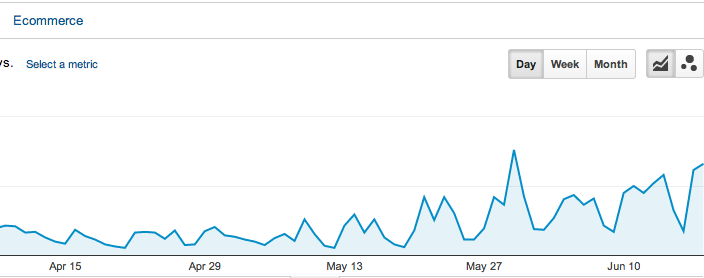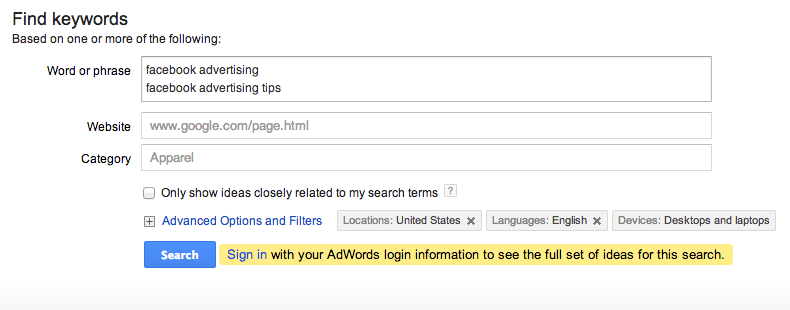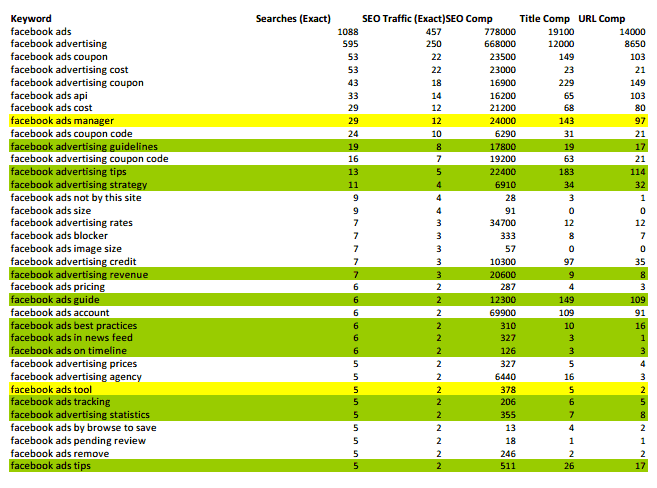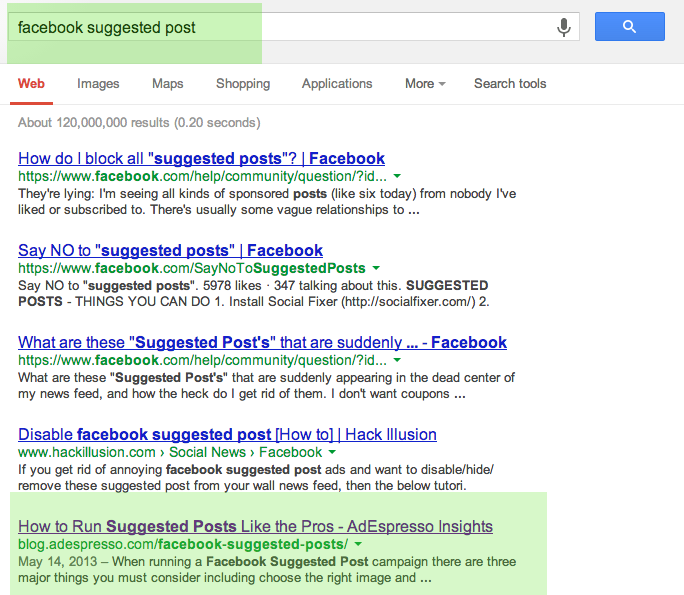

How We Increased Organic Blog Traffic by 203.5% in Less Than 3 Months – And You Can Too
This is a guest contribution by Kristina Allen, marketing consultant for AdEspresso.
Over the past couple of months my team at AdEspresso has increased our organic blog traffic by 203.5% and I’m going to share the secret of exactly how we did it!
Step 1: Conduct Keyword Research
When we first started working on driving (more) organic traffic to the AdEspresso blog our team began with keyword research. We used SEOmoz but you can easily get a keyword list using Google’s free Keyword Research Tool.
When using Google’s keyword tool simply type in a couple of relevant key phrases and then Google will search for related keyword ideas along with their search volume.
Because Facebook advertising is a really popular topic the overall keyword list is pretty gigantic so I immediately sorted the list by highest number of searches.
I then went through and highlighted in green the keywords that I thought I could easily turn into blog post topics. (I also highlighted in yellow keywords that I thought would be good for us to try and use as anchor text in link backs to our site – but that is for a different project).
The keywords I did not highlight were skipped over because they were either too generic or would not have made a good blog post topic for us. For example, “facebook ads coupon” was skipped over because we do not have any Facebook ad coupons to give away and a blog post about Facebook ad coupons wouldn’t have helped us drive the right people to our blog.
Most people who use Facebook ad coupons are first-time social advertisers who are looking to experiment with Facebook ads. Our software is made for Facebook advertisers who know what they’re doing and are looking for an easier way to create ads and also deeper insights into the performance of their campaigns.
It’s really important to select your keywords carefully because the goal of increased traffic shouldn’t be about getting a bunch of people to visit your site for a few seconds. It should be about driving high quality traffic.
Step 2: Include Keywords in the Post URL
Once you have your list of keywords it’s time to get to writing! Simply start going down the list and turning keyword ideas into blog post topics.
For example, one of the keyword phrases we researched and deemed appropriate for our blog was “facebook ads on mobile” since AdEspresso can help you create and analyze mobile Facebook ad campaigns. With the keyword phrase “Facebook ads on mobile” in mind I wrote a post called 5 Tips for Rocking Facebook Ads on Mobile Devices and published it to the AdEspresso blog. I made sure to include the keyword phrase in the URL of the blog post like this for SEO purposes:
Another keyword phrase we want to rank for is “Facebook Suggested Posts” I wrote a post called How to Run Suggested Posts Like the Pros. The URL for the post includes the keyword phrase of course:
However, you will notice the title of the post does not include the word Facebook in it at all. That is because I thought How to Run Facebook Suggested Posts Like the Pros didn’t sound quite right. However, the body copy does include the word Facebook quite a bit and we are still able to rank for the phrase in Google:
This leads us nicely into step three…
Step 3: Include Keywords in the Post
When you’re putting together your post be sure to include your targeted keyword phrase in body copy of your blog post frequently but naturally. Do not keyword stuff your post as this will likely get your penalized by Google and will definitely turn away intelligent readers.
What I do is write a post draft without thinking about adding the keyword phrase in at all. This allows me to focus on creating high quality content without worrying about the technicalities that come along with SEO.
After the post is finished I go back and see if and where I included the keyword phrase naturally. Usually I’ve included it enough times naturally that I do not need to make any edits. Sometimes I’ll have words flipped around a little bit and just need to make small adjustments with phrasing.
For example, using the keyword phrase “Facebook suggested post” I might have written “when putting together a suggested post on Facebook you should…” in my article. If so, I’ll just adjust it so that it reads, “A Facebook suggested post should include…” allowing me to get my target keywords in while saying essentially the same thing in a natural way.
Step 4: Stick to a Posting Schedule
One of the top rules for building up readership for any blog is to stick to a posting schedule. Whether you’re running a business blog or a personal one, frequency + high quality content will get you far.
Sometimes the hardest part of sticking to a schedule is wondering what you should blog about next – that’s the beauty of having a keyword list. You’ll never run out of great ideas! You can quickly go down your list and find a topic that people are actively searching for and help them out!
If you have a business blog, research shows that the more often you post the better your customer acquisition results will be:
Since we started actively trying to increase organic traffic to our blog we have been posting twice per week on Tuesdays and Thursdays. While we would love to post more frequently, we’re a small startup team and we all have a million things to do. Posting twice per week is a schedule that we know we can manage and stick to, so that’s what we’re doing for now – and the results are positive!
Step 5: Understand that Growth May Be a Slow Process
When it comes to increasing organic traffic for your blog, understand that it may be a slow process. Unlike posts that go viral through social media channels, organic traffic takes time to build; however, it is often the gift that keeps on giving for years down the road.
A post that goes viral will likely send you a lot of traffic over the course of a day, week or even a month and then die down. A post that drives organic traffic will continue to send you a steady stream of visitors over the long haul. That’s precisely why organic traffic is highly important for any blog. While you are building up your organic traffic you should also be sharing your posts via social media and bookmarking sites for the biggest boost.
And there you have it, the step-by-step process we followed to grow our organic blog traffic by 203.5%! We’ll continue to follow this process (and stay up to date with trends in SEO) to provide high quality content for our blog readers on topics we know they’re searching for information about.
This post was written by Kristina Allen, marketing consultant for AdEspresso, a Facebook ads manager that allows you to quickly create and a/b test Facebook ads for maximum campaign results!
Originally at: Blog Tips at ProBlogger
How We Increased Organic Blog Traffic by 203.5% in Less Than 3 Months – And You Can Too
Facebook comments:
No Comments »
No comments yet.
RSS feed for comments on this post. TrackBack URL
Leave a comment






















